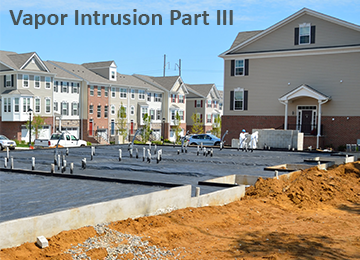Last month in Vapor Intrusion Part II, we discussed how the volatile organic compounds (VOCs) get from the soil and groundwater into buildings. So what? What’s the harm? Can’t see them, can’t taste them, and can’t hear them. What’s all the stink about anyway?
Let’s step back a second and talk about how these VOCs (or other contaminants) can get in your body. Contaminants can generally enter your body three ways.
- Through your mouth – ingestion. Think dirty hands covered with contaminated soil, and then you eat your peanut butter and jelly sandwich at the job site. Or you walk through some contaminated soil and then track the dirt into your house where your 12-month old is crawling around on the rug. Ever see where a baby puts its hands and feet?
- Through your skin – dermal contact. Your skin is pretty tough, but certain contaminants can be absorbed through the skin.
- Through your lungs – inhalation. You breath in VOCs, and they move very easily from your lungs into your blood and on into the artery highway to your internal organs. Inhalation is the worst of the pathways with respect to VOC vapors.
Feeling a little queasy yet?
Now let’s not panic. It generally takes years or decades for these contaminants to affect your body. We call this chronic exposure, like the exposure workers received from asbestos. These folks breathed in the asbestos fibers over decades, but the results were lung cancer. Then there is acute exposure, which is quick and relatively sudden, like breathing in cyanide gas. Both pathways are through the lungs, but the timing of the result is different.
Of the VOCs we have been talking about, benzene is associated with petroleum releases. Tetrachloroethene (PCE) and trichloroethene (TCE) are associated with various types of solvents that are considered carcinogens. These VOCs, along with many others, may also affect your liver, lungs, digestive system and nervous system.* The effects from these VOCs are generally from chronic exposure, not acute exposure (however, too much of anything can cause an acute reaction).
So I ask you, knowing what we know about chronic exposure to asbestos, if the end result were the same from chronic exposure to PCE or benzene, would you not be just as concerned? Well, the professionals (toxicologists, physicians, biologists) that study these chemicals and their effects on human organs have determined that long-term exposure to many VOCs is harmful. Some recent studies** have shown exposure to TCE can affect the developing heart in the fetus during the first trimester. This study has obviously created quite a stir in the environmental community, and a lot of work needs to be done to confirm the early study. But why put ourselves in situations where we are exposed to the harmful effects from VOCs? We ban smoking in buildings, yet we stand over the gasoline pump nozzle when we pump our gasoline. Hello, some nasty VOCs are in those fumes. We walk through the newly sprayed grass lawn (fertilizers, herbicides, and pesticides), and then walk across the carpet when we get home. Let’s be smart and reduce those exposures.
Next month, we will discuss how we “look” for VOCs in a building and what we compare the concentrations with to determine if there is an exposure risk.
*In full disclosure, I am not a toxicologist, physician, or biologist.
**Study References:
EPA, Integrated Risk Information System (IRIS) Chemical Assessment Summary, Trichloroethylene; CASRN 79-01-6, available at http://cfpub.epa.gov/ncea/iris/iris_documents/documents/subst/0199_summary.pdf;
Paula D. Johnson, et al., Threshold of Trichloroethylene Contamination in Maternal Drinking Waters Affecting Fetal Heart Development in the Rat, Environmental Health Perspectives, March 2003, at 289–292, available at http://www.ncbi.nlm.nih.gov/pmc/articles/PMC1241384/pdf/ehp0111-000289.pdf [hereinafter Johnson study].
Read the Series:
Who Is Intruding My Space? Vapor Intrusion, Part II
Where is Vic? Vapor Intrusion, Part IV
Bye, Bye VIC, Vapor Intrusion Part V
About the Author: John Stewart, PG, CPG
Mr. Stewart is a Chief Geologist for ECS. He has conducted hydrogeologic site investigations at a variety of sites including NCDOT Right-of-Way corridors, Brownfields properties, landfills, industrial sites including textile and furniture plants, machine shops, chemical manufacturing plants, commercial shopping facilities, dry cleaners, and gasoline stations.

